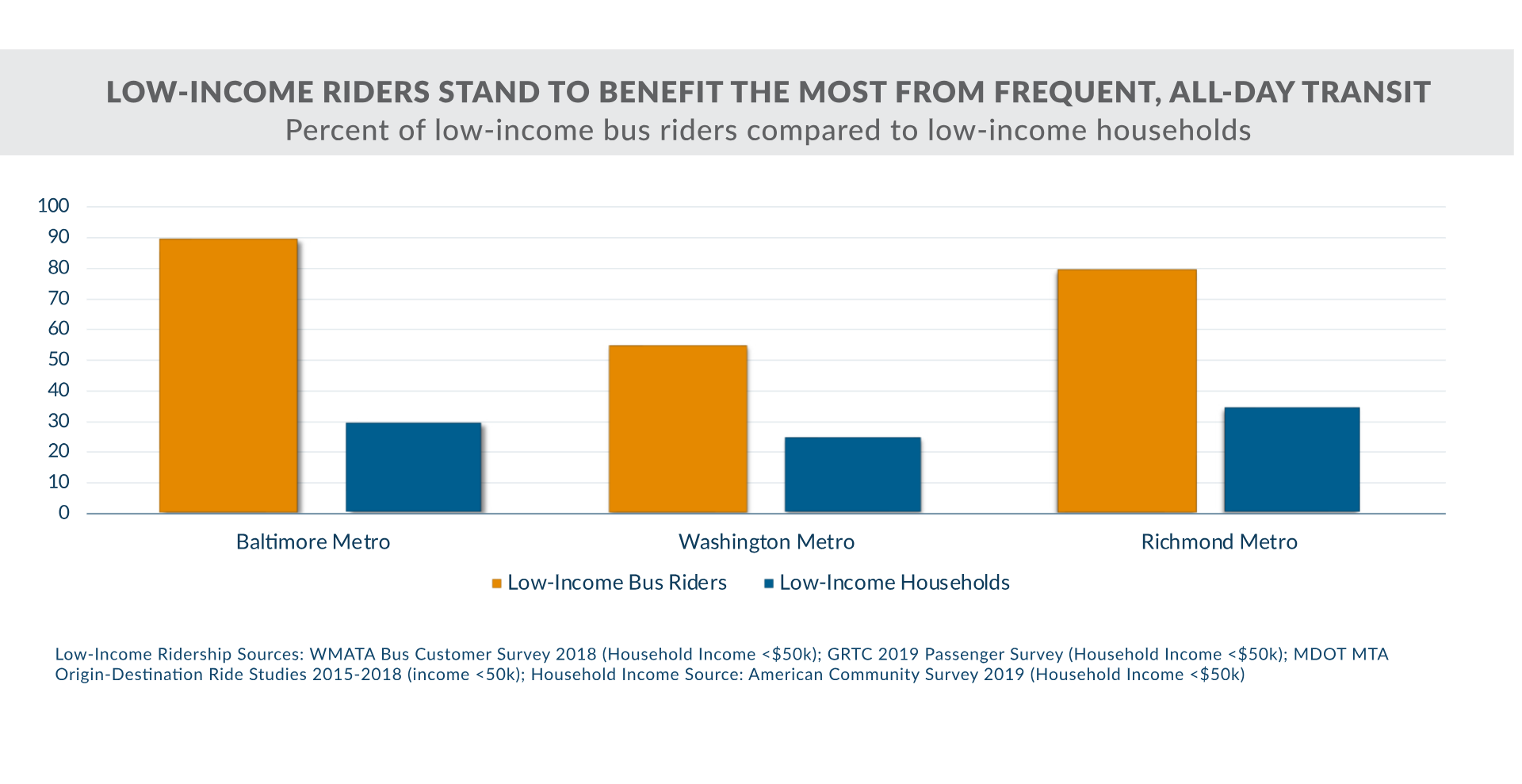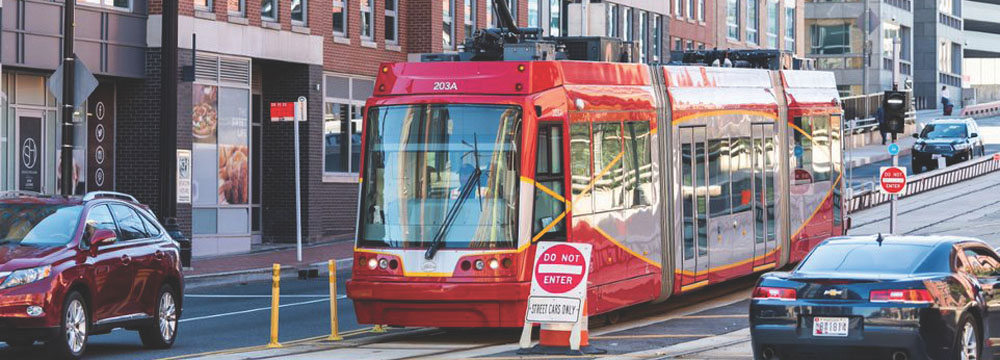Solutions
Case Studies
Case studies highlight local business and initiatives who are making strides in building a better tomorrow
In 2018, the Partnership published the Capital Region’s Blueprint for Regional Mobility which lays out a plan to connect the
super-region, improve the consumer experience, ensure equitable access, and integrate innovation in our regional transportation system. The transportation solutions in this pillar sharpen our focus to ensure we prioritize solutions that can create a more prosperous, equitable, and resilient region for people of all backgrounds and incomes, and particularly for those facing the greatest barriers
Transportation and digital infrastructure enable our region to connect through work, school, and play. Widespread accessibility to high-performing infrastructure is an economic imperative and is critical to achieving inclusive growth.
Unfortunately, access to such infrastructure is not equal across the Capital Region. Black, Hispanic, and low-income households in the Capital Region are more likely to have longer commute times and worse access to high-performing transit options, while also being less likely to have access to a car or broadband internet.
Black residents in the Capital Region are almost 3x as likely as white residents to live in areas
with poor transit accessibility to jobs and low vehicle ownership.
Households
in poverty are almost 2.5x more likely to live in areas with poor transit access to jobs227
Inequitable access to transportation infrastructure can affect commute times, especially for those who work outside of traditional 9-to-5 weekday schedules. Even within the same city, a trip across town on public transportation can cost a rider several hours depending on the time of day.228 These inequities in access shape what work and educational opportunities are available to residents and disproportionately impact Black, Hispanic, and low-income communities.
Longer commute times reduce the jobs, housing, and services that can be accessed for residents, and impact employers’ ability to recruit and retain a productive workforce.
Connectivity does not encompass transportation alone – it also includes digital infrastructure. Reliable household-level internet connection is a necessary utility to generate income, buy products and services, engage in education, and obtain real-time information. In crisis situations like the COVID-19 pandemic or climate disasters, reliable digital connectivity is imperative for sustaining livelihoods and participating in society.
Yet, despite its critical relevance, reliable and affordable broadband is not currently available to all. Many in rural areas or communities of color lack this digital infrastructure, which in turn reduces education opportunities for students and work prospects for job seekers, and excludes communities from information channels, voting opportunities, and health care services.
Digital access and proximity to accessible transportation are two sides of the same coin: participation in the modern economy typically requires both, and those with better access tend to have better outcomes. Investing in the expansion of digital and transportation infrastructure for excluded populations will enable more individuals to access and maintain income-generating opportunities, connect to digital learning opportunities, provide for their families, and participate in the economy.
The following section outlines solutions and proposed recommendations to reduce inequities across transportation and digital access, thereby creating a more inclusive and productive economy.
 Baltimore Greenway Trails Network - https://greaterwashingtonpartnership.com/publications/economic-and-social-benefits-of-completing-the-baltimore-greenway-trails-network/
Baltimore Greenway Trails Network - https://greaterwashingtonpartnership.com/publications/economic-and-social-benefits-of-completing-the-baltimore-greenway-trails-network/
 Microsoft Airband Initiative - https://www.microsoft.com/en-us/corporate-responsibility/airband-initiative
Microsoft Airband Initiative - https://www.microsoft.com/en-us/corporate-responsibility/airband-initiative
Case Study:Baltimore Greenway Trails Network
The Partnership partnered with EY and the Rails-to-Trails Conservancy to study the potential impacts of
completing the Baltimore Greenway Trails Network, a 25-mile network of trails that will connect many of
Baltimore’s job centers and educational and cultural institutions with a diverse cross-section of more than
75 neighborhoods.
EY brought their research and technical expertise to the table to examine the social and economic benefits,
including the return on investment, for the City of Baltimore. The report found that, “when compared with the
project’s estimated cost of $28M, the estimated benefits of completing the Greenway far exceed the
investment.” Among the benefits, completion of the
Baltimore Greenway Trails Network could generate up to:
$113 million
per year in direct, indirect, and induced local retail activity near the trail
$48 million
in total economic impacts of trail construction, with $17 million in labor income
$314 million
in aggregate residential property values and new tax revenues of $7.1 million
Replace 8.5 million
vehicle miles traveled with more walking, biking, and transit use
$2.4 million
in annual public health savings resulting from more residents walking and biking
3,900 tons
of carbon emissions avoided
Case Study:Microsoft Airband Initiative
Microsoft is partnering with telecommunications providers and device manufacturers to increase digital
access, affordability, and digital skills through co-investments and subject matter expertise. Launched in
2017, Microsoft has been prioritizing digital infrastructure investments and skills training to close the
digital equity gap nationwide and globally. Their support to-date has included: investments in affordable,
off-grid energy providers; use of low-cost wireless technologies to improve digital inclusion; and financing
the construction of a wireless internet network.
Microsoft also works alongside the public sector to match capital investments with government financial and
regulatory support.
This initiative included a
data-mapping
effort to
showcase the
digital
disparities
nationwide
that are
underreported
by the FCC,
and Microsoft
has advocated
for friendlier
policies
towards small
internet
service
providers to
broaden their
reach through
unutilized TV
infrastructure.
As of 2020, Microsoft successfully stood up more than 90 projects across the globe under this initiative,
which includes partnerships with 12 internet service providers across 24 U.S. states.
By July 2022, Microsoft aims to connect:
3 million
People in the US
40 million
People globally











 Website Development By Top Shelf Design
Website Development By Top Shelf Design